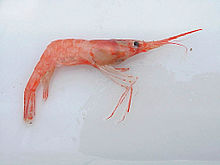- Pandalus borealis
-
Pandalus borealis 
Scientific classification Kingdom: Animalia Phylum: Arthropoda Subphylum: Crustacea Class: Malacostraca Order: Decapoda Infraorder: Caridea Family: Pandalidae Genus: Pandalus Species: P. borealis Binomial name Pandalus borealis
Krøyer, 1838Pandalus borealis is a species of shrimp found in cold parts of the Atlantic and Pacific Oceans. Many different common names are used, including pink shrimp, deepwater prawn, deep-sea prawn, great northern prawn, crevette nordique and northern shrimp.[1]
Contents
Distribution
P. borealis lives at depths of 20–1,330 m (66–4,360 ft), usually on soft muddy bottoms,[1] in waters with a temperature of 2–14 °C (36–57 °F). The distribution of the nominate subspecies P. b. borealis in the Atlantic ranges from New England, Canada's eastern seaboard (off Newfoundland and Labrador and eastern Baffin Island in Nunavut), southern and eastern Greenland, Iceland, Svalbard, Norway and the North Sea as far south as the English Channel. In the Pacific, P. b. eous is found from Japan, through the Sea of Okhotsk, across the Bering Strait, and as far south in North America as Washington state.
Physiology
In their 8 year lifespan,[2] males can reach a length of 120 mm (4.7 in), while females can reach 165 mm (6.5 in) long.[1]
The shrimp are hermaphroditic. They start out male, but after year or two, their testicles turn to ovaries and they complete their lives as females.[2]
Uses by humans
P. borealis is an important food resource, and has been widely fished since the early 1900s in Norway, and later in other countries following Johan Hjort's practical discoveries of how to locate them. In Canada, these shrimp are sold peeled, cooked and frozen in bags in supermarkets, and are consumed as appetizers.
Shrimp alkaline phosphatase (SAP), an enzyme used in molecular biology, is obtained from Pandalus borealis. The species' carapace is a source of chitosan, a versatile chemical used for such different applications as treating bleeding wounds, filtering wine or improving the soil in organic farming.
Management
Northern shrimp have a short life, which contributes to a variable stock on a yearly basis. However, the species is not considered overfished due to a large amount reported and a large amount harvested.
In Canada, the annual harvest limit is set to 164,000 tonnes (2008).[2] The Canadian fishery began in the 1980s and expanded in 1990s.
References
- ^ a b c "Pandalus borealis (Krøyer, 1838)". Species Fact Sheet. Food and Agriculture Organization. http://www.fao.org/fishery/species/3425/en. Retrieved November 2, 2010.
- ^ a b c "Guide to Responsible Sourcing Guide. Cold-water prawns". Seafish. April 2007. http://www.seafish.org/upload/file/cold_water_prawn_web_version/Prawn%20Factsheet2%20A4s.pdf. Retrieved November 2, 2010.
External links
External identifiers for Pandalus borealis EOL 318602 ITIS 96967 NCBI 6703 WoRMS 107649  Media related to Pandalus borealis at Wikimedia Commons
Media related to Pandalus borealis at Wikimedia Commons
Categories:- Caridea
- Edible crustaceans
- Commercial crustaceans
- Animals described in 1838
Wikimedia Foundation. 2010.

